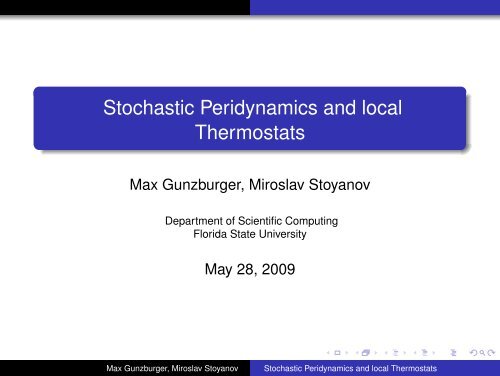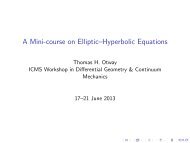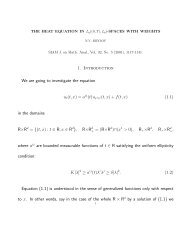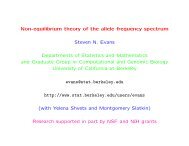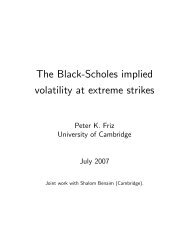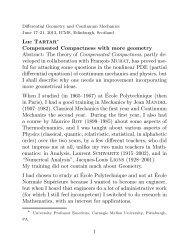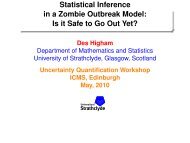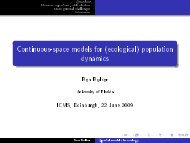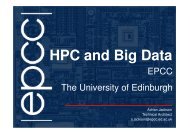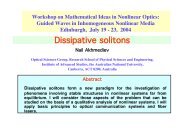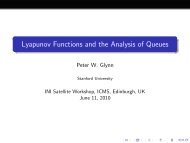Stochastic Peridynamics and local Thermostats - ICMS
Stochastic Peridynamics and local Thermostats - ICMS
Stochastic Peridynamics and local Thermostats - ICMS
You also want an ePaper? Increase the reach of your titles
YUMPU automatically turns print PDFs into web optimized ePapers that Google loves.
<strong>Stochastic</strong> <strong>Peridynamics</strong> <strong>and</strong> <strong>local</strong><br />
<strong>Thermostats</strong><br />
Max Gunzburger, Miroslav Stoyanov<br />
Department of Scientific Computing<br />
Florida State University<br />
May 28, 2009<br />
Max Gunzburger, Miroslav Stoyanov<br />
<strong>Stochastic</strong> <strong>Peridynamics</strong> <strong>and</strong> <strong>local</strong> <strong>Thermostats</strong>
Molecular Dynamics<br />
For a solid to which we apply some force, we consider the<br />
equation for motion of each individual molecule.<br />
where<br />
m i ÿ i (t) = − ∂U(y)<br />
∂y i<br />
m i is the mass of the i-th particle,<br />
y i (t) is the position,<br />
U(y) is the potential energy,<br />
B MD<br />
i<br />
is the external force.<br />
N∑<br />
m i ÿ i =<br />
j=0,j≠i<br />
+ B MD<br />
i , (1)<br />
F(y i , y j ) + B MD<br />
i . (2)<br />
Max Gunzburger, Miroslav Stoyanov<br />
<strong>Stochastic</strong> <strong>Peridynamics</strong> <strong>and</strong> <strong>local</strong> <strong>Thermostats</strong>
Starting with<br />
Continuum Mechanics<br />
m i ÿ i (t) = − ∂U(y)<br />
∂y i<br />
+ B MD<br />
i , (3)<br />
Continuum Mechanics replaces the discrete y i (t) with a<br />
continuous function y(t, x), then the model is transformed into:<br />
ρ(x)ÿ(t, x) = y xx (t, x) + y yy (t, x) + y zz (t, x) + B CM (x), (4)<br />
where ρ(x) is the mass density of the material <strong>and</strong> B CM is the<br />
external force measured in the appropriate units.<br />
Max Gunzburger, Miroslav Stoyanov<br />
<strong>Stochastic</strong> <strong>Peridynamics</strong> <strong>and</strong> <strong>local</strong> <strong>Thermostats</strong>
Starting with<br />
m i ÿ i =<br />
<strong>Peridynamics</strong><br />
N∑<br />
j=0,j≠i<br />
F(y i , y j ) + B MD<br />
i , (5)<br />
<strong>Peridynamics</strong> models combine the best of both worlds. Let<br />
u(t, x) be the displacement field for the ”particles” <strong>and</strong><br />
y(t, x) = x + u(t, x), then<br />
∫<br />
ρ(x)ü(t, x) = f (u(t, x ′ ) − u(t, x), x ′ − x)dx ′ + B PD (x). (6)<br />
H x<br />
Max Gunzburger, Miroslav Stoyanov<br />
<strong>Stochastic</strong> <strong>Peridynamics</strong> <strong>and</strong> <strong>local</strong> <strong>Thermostats</strong>
∫<br />
ρ(x)ü(t, x) = f (u(t, x ′ ) − u(t, x), x ′ − x)dx ′ + B PD (x),<br />
H x<br />
(7)<br />
where<br />
ρ(x) is the mass density of the material,<br />
f (·, ·) is a force density kernel,<br />
H x is a neighborhood of interaction around x,<br />
the region H x is usually a sphere centered at x with some<br />
fixed radius δ.<br />
This is non-<strong>local</strong> model since ”particles” separated by finite<br />
distance are allowed to interact through the kernel.<br />
Max Gunzburger, Miroslav Stoyanov<br />
<strong>Stochastic</strong> <strong>Peridynamics</strong> <strong>and</strong> <strong>local</strong> <strong>Thermostats</strong>
Crack Dynamics<br />
We rewrite the <strong>Peridynamics</strong> model as<br />
∫<br />
ρ(x)ü(t, x) = µ(u(t, x ′ ), u(t, x), x ′ , x)f (u(t, x ′ ) − u(t, x), x ′ − x)dx ′ ,<br />
H x<br />
where the function µ(u ′ , u, x ′ , x) gives values of 0 <strong>and</strong> 1 as<br />
µ(u ′ , u, x ′ , x) =<br />
{ 1, if x ′ <strong>and</strong> x are “connected”,<br />
0, if x ′ <strong>and</strong> x are “disconnected”.<br />
(8)<br />
We can further make µ(·) history dependent, that means once<br />
cracks form, we don’t let them ”heal”.<br />
Max Gunzburger, Miroslav Stoyanov<br />
<strong>Stochastic</strong> <strong>Peridynamics</strong> <strong>and</strong> <strong>local</strong> <strong>Thermostats</strong>
<strong>Stochastic</strong> Thermostat for Molecular Dynamics<br />
where<br />
m i ÿ i = − ∂U(y)<br />
∂y i<br />
T is the temperature,<br />
Γ is a friction coefficient,<br />
κ B is the Boltzmann’s constant,<br />
+ B MD<br />
i −Γm i ẏ i + √ 2m i κ B T ΓdW i (t), (9)<br />
dW i is independent normalized Weiner noise.<br />
Max Gunzburger, Miroslav Stoyanov<br />
<strong>Stochastic</strong> <strong>Peridynamics</strong> <strong>and</strong> <strong>local</strong> <strong>Thermostats</strong>
We wish to upscale this to the <strong>Peridynamics</strong> model:<br />
∫<br />
ρ(x)ü(t, x) = f (u(t, x ′ ) − u(t, x), x ′ − x)dx ′ + B PD (x)<br />
H x<br />
−Γρ(x) ˙u(t, x) + √ 2ρ(x)κ B T ΓdŴ (t, x). (10)<br />
The discrete Weiner noise transforms into white noise dŴ (t, x)<br />
throughout the domain, with units of square root of volume time<br />
inverse (i.e. m − 3 2 s − 1 2 ).<br />
Max Gunzburger, Miroslav Stoyanov<br />
<strong>Stochastic</strong> <strong>Peridynamics</strong> <strong>and</strong> <strong>local</strong> <strong>Thermostats</strong>
Project Goals<br />
current <strong>Peridynamics</strong> models for cracks are mainly<br />
deterministic with respect to all of the material properties,<br />
we wish to add stochastic perturbation to both f (·, ·) <strong>and</strong><br />
the additive stochastic thermostat, this will create more<br />
realistic <strong>and</strong> more interesting behavior for cracks formation<br />
<strong>and</strong> growth as well as the general displacement field,<br />
energy criteria for formation of cracks may also need<br />
revision.<br />
Max Gunzburger, Miroslav Stoyanov<br />
<strong>Stochastic</strong> <strong>Peridynamics</strong> <strong>and</strong> <strong>local</strong> <strong>Thermostats</strong>
Thank you!<br />
For details please, see my poster.<br />
Max Gunzburger, Miroslav Stoyanov<br />
<strong>Stochastic</strong> <strong>Peridynamics</strong> <strong>and</strong> <strong>local</strong> <strong>Thermostats</strong>


